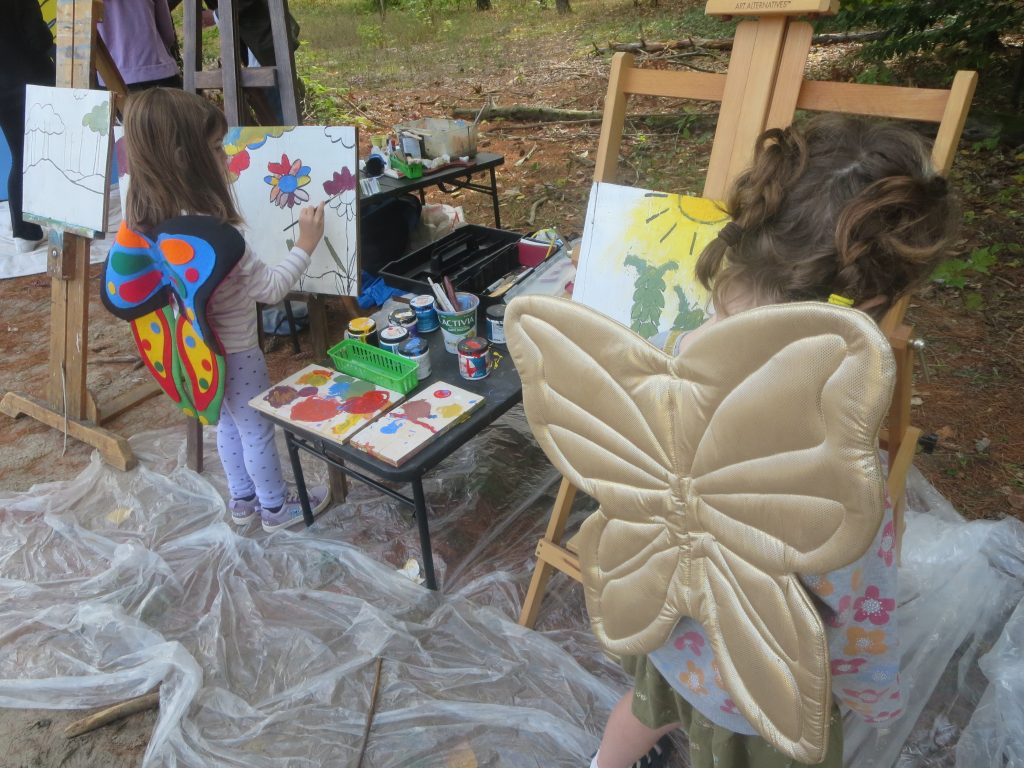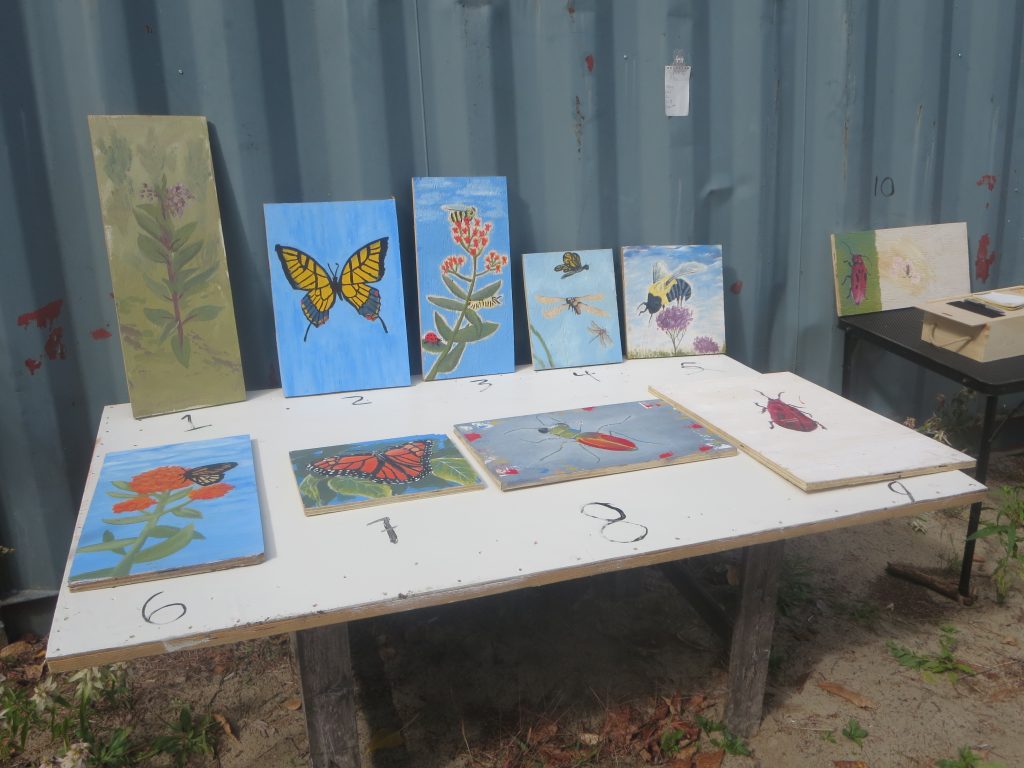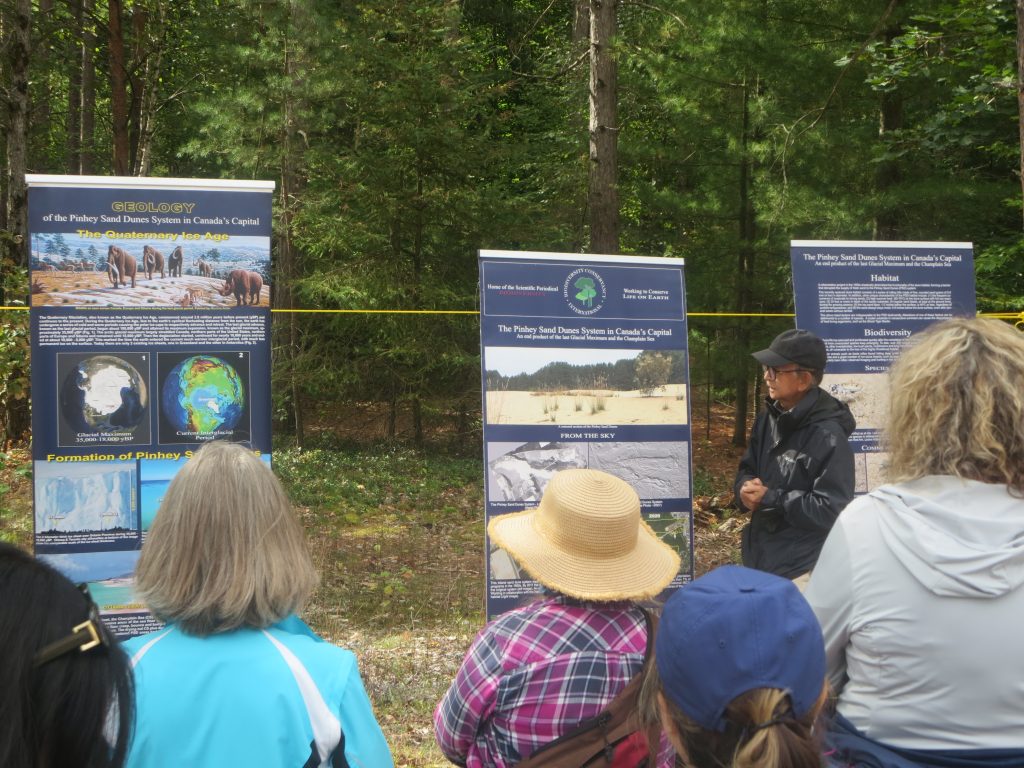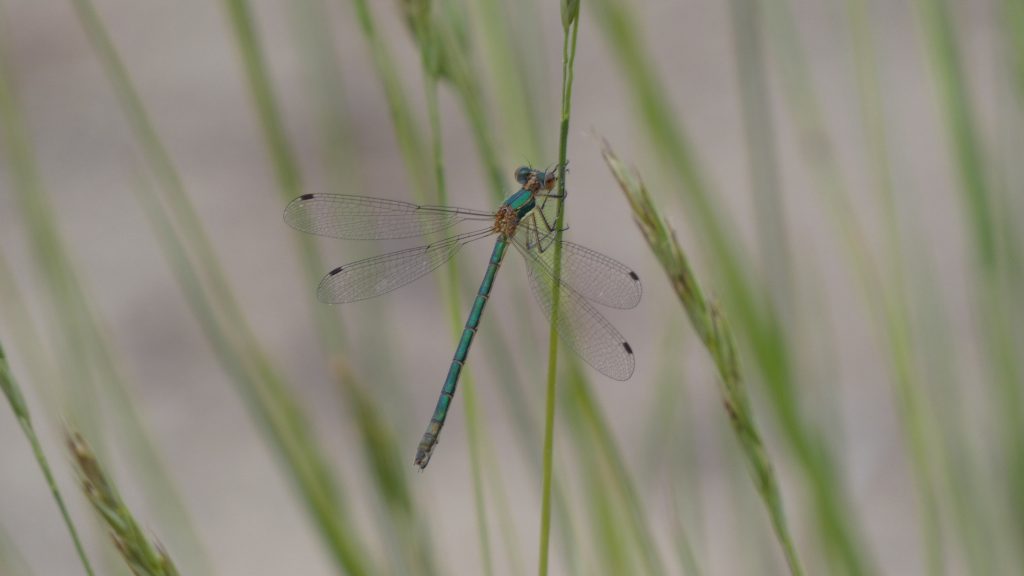This newsletter includes:
- September roundup of dune, volunteer, NCC, tour, and fundraising activities
- A guide to dragonflies and damselflies
- BCI work on biodiversity in Vietnam
- How to help the Pinhey Sand Dunes through donations
Flora and Fauna Settle into Late Summer While the NCC Takes a Bigger Interest

The weather continued hot through most of September and work – both human and insect – has continued apace at the Pinhey Sand Dunes, even as the flowering plants started to die back.
Volunteers worked hard to build up and sift the sand at the Western dune at Dune #1 in particular and, being clean and deep, is now home to very many tell-tale round entryways to Ghost Tiger Beetle dens. On September 12, around 28 environmental students from Carlton University conducted some randomized counting to study population changes. We still have lots of Giant Swallowtail caterpillars, some starting to build cocoons, both at Dune #1 and, smaller ones, from Dune #2 and there have been a few Monarch sightings, though fewer than last year. Antlions are making themselves known though their long twin tracks through the sand.
The National Capital Commission (NCC) has been paying us a lot of attention, visiting with Directors, the Capital Planning Group, and students from Queens University to see how we are faring. It kindly provided the dunes with a garbage bin, Muskoka chairs, benches, and a picnic table to make contemplating this special spot much more comfortable. Additionally, the NCC brought in huge equipment to remove trees felled by the 2022 derecho, leaving tidy piles of wood chips. Two large areas of Dunes #1 and #2 look much clearer but still left volunteers lots of raking and weeding work to do. We are very grateful.
Otherwise, education work continues with regular tours, including with the Vietnam ambassador and, on September 27, hosting a Carleton University Geoheritage Day event aimed at teaching visitors about “exceptional” geological sites in Canada. Meanwhile, the mural is getting closer to being finalized with our artists using virtual reality headsets, as well as the naked eye, to make sure they get everything right.
Big Turnout at September 7 Fund-raising and Outreach Event
By Chris Dragan
A flurry of visitors came to the Pinhey Sand Dunes #2 for the latest fund-raising and outreach event, including a large group of hikers who stopped to take a tour and two young (winged!) friends of the dune – seen above – who contributed to the artworks on display. A silent auction was held for 10 Pinhey Sand Dunes flora and fauna artworks. The proceeds are destined for ongoing outreach and education activities. Pieces are still available. Contact Aaron@biodiversityconservancy.org if you are interested in bidding.


Art Auction (left); Dunes tour (right). By Chris Dragan
September 14 Nature Photography Tour
by Chris Dragan
Frank Moore led a group of keen photographers on a tour of Sand Dunes #1 and #2 to show them the best tips and tricks for taking pictures of the sites and its residents. Some key things to keep in mind are: stay outside the cordoned off areas until you have authorization from an organizer, follow the rope on the ground if one is available to avoid disturbing the burrows of the insects, and finally, if you find an interesting subject, place a common object beside it (pen, coin, button, etc.) to make it easy to get a sense of scale. If you’re interested in more pointers about taking pictures at the sand dunes, contact Frank at frankmoore@biodiversityconservancy.org
A Visitor’s Guide to Dragonflies and Damselflies
By Alyssa Nolan
If you visit the Pinhey Sand Dunes on a warm afternoon, you may notice quick flashes of colour low over the sand or perching on grasses. These are dragonflies (Anisoptera) and damselflies (Zygoptera), two related groups of insects hundreds of millions of years old. They may look delicate, but they are some of the best hunters in the insect world, feeding on mosquitoes, midges, and other small insects.
It’s easy to tell them apart once you know how. Dragonflies are the larger and sturdier fliers, resting with their wings spread wide and flat. Their big eyes usually meet at the top of the head, giving them excellent vision for hunting. Damselflies are slimmer, with widely spaced eyes, and they fold their wings neatly over their backs when at rest. Think of dragonflies as fast, direct “helicopters” and damselflies as light, fluttering “butterflies.”

The Pinhey Sand Dunes themselves are dry, but that doesn’t keep these insects away. Dragonflies and damselflies breed in ponds, wetlands, and rivers across Ottawa, and many individuals wander into the dunes to hunt. Their presence adds movement and brightness to the dunes, a reminder of the rich ecosystems surrounding this unusual pocket of sand.
Around Ottawa, bright red meadowhawks are among the most common dragonflies you’ll spot. Larger species such as the Common Green Darner (Anax junius) or Twelve-spotted Skimmer (Libellula pulchella) sometimes cruise over open areas too. Among damselflies, the shimmering blue Bluets (Enallagmacyathigerum) are common near wetlands and may occasionally wander the dunes. Though, dragonflies and damselflies do more than add beauty to the landscape. Each dragonfly can eat dozens to hundreds of small insects in a day, making them natural pest control. And because their young depend on clean water, their abundance across Ottawa is a good sign of a healthy environment.
Watching these insects can be a highlight of a September walk. You may see males patrolling a favourite perch or even pairs linked together in their heart-shaped mating flight before moving back to wetter areas to lay eggs. Even if they don’t breed here, their regular appearances at the Pinhey Sand Dunes make them welcome visitors.
Quick tips for spotting them:
- Look for perches, bare sand, sticks, or grass stems where they like to rest.
- Watch for repeated patterns. Dragonflies often patrol the same small hunting area.
- Be patient. If you stand still, they will often return to the very spot you’re watching.
BCI Sends Bamboo Saplings to Vietnam to Promote Biodiversity
By Karen Lane
Biodiversity Conservancy International (BCI) is also promoting biodiversity in Vietnam as well as at the Pinhey Sand Dunes. Just this month, BCI sent 80 one-year-old Moso bamboo saplings to Hue in central Vietnam. This followed an initial 20 sent in March. The saplings will be planted on an island in Hue’s Perfume River, known as the Con Da Vien. Up to 200 more saplings will be sent in February next year and planted during the 2026 Lunar New Year celebrations.
Use of chemicals like agent orange during the war in Vietnam that ended in 1975 and widespread post-war planting of non-native acacia hardwood trees to bring in income has led to dangerous biodiversity loss, ecosystem disruption, and vulnerability to monoculture. The goal of BCI’s bamboo project is to create an attractive 1-2 hectare bamboo forest which will draw tourists, and more importantly, be a living showcase to exhibit the high value of bamboo to the environment and the myriad of its uses, particularly to providing livelihoods. It is hoped this will encourage acacia farmers to switch to planting bamboo instead. Fast-growing bamboo, which is a key native plant species, is crucial to supporting the replanting of the slow-growing biodiversity-rich forests of Vietnam. To hear more about the project or to get involved, contact Pete Dang at dangpt@biodiversityconservancy.org
Donating to BCI and Friends
Did you know that Biodiversity Conservancy International is a registered charity? BCI was registered in 1997 as a charity under the name Tropical Conservancy Corporation and changed its name in 2012. To financially support restoration and education efforts at the Pinhey Sand Dunes, you can donate via e-transfer, cheque, or Benevity. See detailed instructions here.
